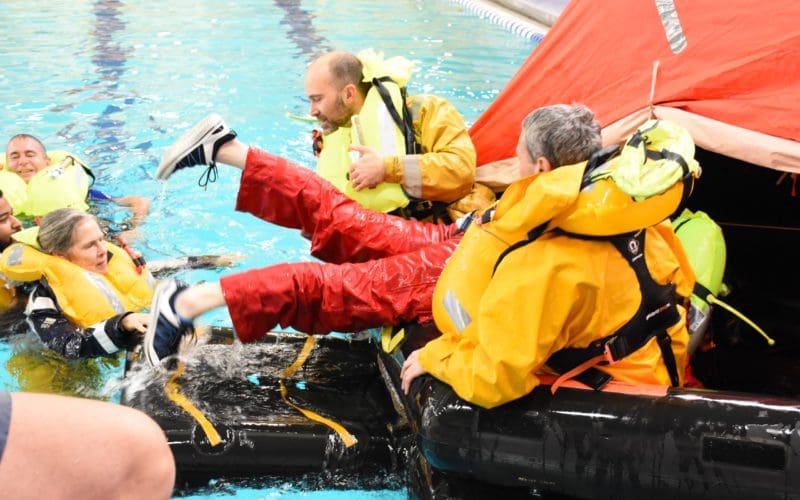Not many people are better positioned to discuss Safety at Sea than former US Navy nuclear attack sub captain Mark Lenci. After 26 years in the Navy, Lenci now teaches the Cruising Club of America’s Safety at Sea Seminars. Mariners learn how to fight fires, recover MOBs, climb into life rafts, and shoot off flares. Ocean Navigator reached Lenci by email.
[gtx_gallery]
Ocean Navigator: What’s the biggest value of attending a Safety at Sea course? Is it specific knowledge gained or is it more the experience of getting aboard a life raft or putting out an actual fire?
Mark Lenci: In my opinion, there are three unique things gained through the hands-on course (which includes the online course):
1. Knowledge gained in a broad range of safety at sea subjects. This knowledge is gained primarily through the excellent 15 module online course developed by host organizations and US Sailing.
2. Exposure to a wide variety of the latest equipment and to different approaches to safety issues.
3. Hands-on experience that is very difficult or impossible to do on your own. Life rafts, using flares (Our CCA/NYYC program is unique in that all students can actually use all types of flares including SOLAS parachute flares due to our venue), extinguishing fires, leak trainer (another unique feature of the CCA/NYYC program), etc.
ON: What is your leak trainer setup and what are the main concepts you’re trying to teach with it?
ML: The CCA/NYYC leak trainer is a 10-foot section of one side of the hull cut out of a 32-foot sailboat. This hull section, including interior built-in benches, is mounted in a large pan on a trailer. Water is pumped to various water boxes and hoses that have been added to the hull. The instructor can start leaks in hoses, some of which can be stopped by shutting a valve, and some that can only be stopped by patching the hose. The instructor can also start a leak due to a crack in the hull. The water pressure is the same as would be encountered with the hull afloat. Students get the experience of seeing how various bilge pumps can handle different-sized leaks. The students work in small teams, as a crew would, to find and stop the leaks.
The idea for this leak trainer comes from the US Navy’s submarine force full-size leak trainers in New London, CT. (Our instructor is a 20-year retired submariner.)
ON: How much do you stress the value of having exposure suits for everyone in the crew? Do you train in putting on an exposure suit?
ML: We discuss exposure suits in the online course and briefly in the hands-on day. We treat exposure suits as something that should be considered for specific situations. If a boat may encounter these specific conditions, then they should consider taking exposure suits.
Major offshore races in the US generally do not require exposure suits. We do not say that we recommend every boat carry them offshore.
ON: What value do you place on electronic man overboard signaling devices such as the ACR OLAS product? Do you recommend all crew have PLBs?
ML: HUGE!! ENORMOUS!!! We really spend a lot of time on these devices, including a video on how to set them up and a live demo of inflating a PFD, activating an AIS MOB beacon also with DSC, and receiving the signals on a multifunction display and a VHF radio. We consider the AIS MOB devices the most significant advance in person overboard recovery in the last two decades. Note that many offshore races require them.
Note that we are talking about AIS MOB devices (which now all include DSC capability). We are not talking about PLBs. PLBs are nice and work on land and sea. However, a PLB alerts a satellite and a land-based service. A PLB does not alert anyone in the vicinity. The huge difference with AIS MOB devices is that any vessel in VHF range of the AIS MOB will be alerted to the position of the MOB.
ON: How much instruction do you provide to attendees on how to properly maintain inflatable PFDs?
ML: A lot! We and other host organizations have ramped up the time spent on PFDs over the last two years due to the various issues that have arisen in the real world. The CCA/NYYC program provides loaner PFDs for anyone that might not have an offshore PFD to ensure everyone gets the full experience. We spend one full hour (of eight hours that we have for the hands-on day) on just PFDs. This includes showing the various models that leading vendors offer, pros/cons, etc. We go through the different mechanisms and pros/cons. We provide a paper we have written on the features, types, and maintenance of PFDs.
This is a super important topic.

